
Parasteatoda tepidariorum, the common house spider or American house spider, is a spider species of the genus Parasteatoda with a cosmopolitan distribution. Common house spiders are synanthropic and live in and near human dwellings. Their prey mechanism is similar to that of the other cobweb spiders: the spider follows disturbances transmitted along the web to entangle and then paralyze its prey, which usually consists of household insects and other invertebrates.
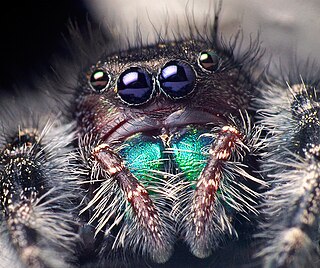
Phidippus is a genus in the family Salticidae. Some of the largest jumping spiders inhabit this genus, and many species are characterized by their brilliant, iridescent green chelicerae. Phidippus is distributed almost exclusively in North America, with the exception of two exported species. As of January 2021, there were about 80 described species in the genus. Species previously described in Phidippus which are found in India and Bangladesh do not belong in this genus.
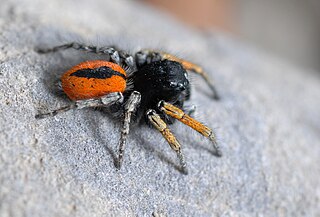
Philaeus chrysops is a species of jumping spider (Salticidae).

Phidippus audax is a common jumping spider of North America. It is commonly referred to as the daring jumping spider, or bold jumping spider. The spider belongs to the genus Phidippus, a group of jumping spiders easily identified both by their relatively large size and their iridescent chelicerae.
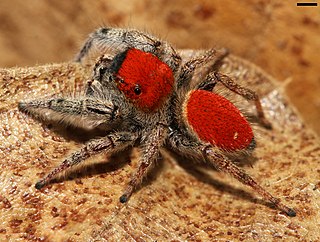
Phidippus whitmani is a species of jumping spider.

Phidippus cardinalis is a species of jumping spider. It is commonly called cardinal jumper. It is one of the species of jumping spiders which are mimics of mutillid wasps in the genus Dasymutilla ; several species of these wasps are similar in size and coloration, and possess a very painful sting.
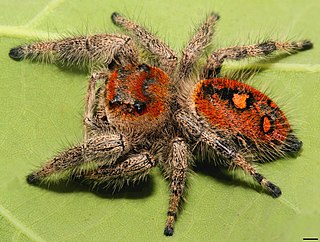
Phidippus regius, known commonly as the regal jumping spider, is a species of jumping spider in eastern North America.

Mopsus mormon is an Australian spider species of the family Salticidae. It is the sole species in the genus Mopsus. It is found in New Guinea and eastern Australia. It is commonly called the green jumping spider.
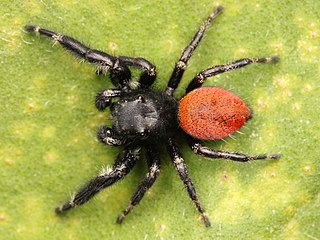
Phidippus johnsoni, the red-backed jumping spider, is one of the largest and most commonly encountered jumping spiders of western North America. It is not to be confused with the unrelated and highly venomous redback spider.

Phidippus californicus is a species of jumping spider. It is found in the southwestern United States and northern Mexico.

Phidippus octopunctatus is a jumping spider that occurs in the United States and Mexico, mostly in the Great Basin Desert. It is among the largest jumping spiders found in North America, approaching 25 millimetres (0.98 in) in body length. They are gray to brownish-gray in color.
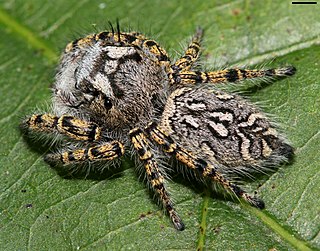
Phidippus mystaceus is a species of jumping spider that is found in North America. Females grow to about 1 centimetre (0.39 in) in body length.

Phidippus otiosus is a species of jumping spider that is found in southeastern North America. It is primarily a tree-living species. Females reach a body length of about 16 mm. Its iridescent fangs can range in color from purple to green.

Phidippus putnami is a species of jumping spider found in the United States.
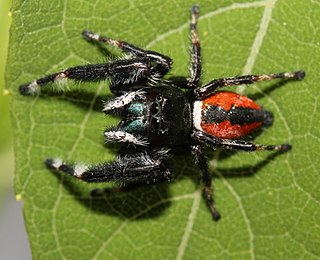
Phidippus clarus is a species of jumping spider found in old fields throughout eastern North America. It often waits upside down near the top of a plant, which may be useful for detecting prey, and then quickly jumps down before the prey can escape. The spider is one of 60 species in the genus Phidippus, and one of about 5,000 in the Salticidae, a family that accounts for about 10% of all spider species. P. clarus is a predator, mostly consuming insects, other spiders, and other terrestrial arthropods.

Portia schultzi is a species of jumping spider which ranges from South Africa in the south to Kenya in the north, and also is found in West Africa and Madagascar. In this species, which is slightly smaller than some other species of the genus Portia, the bodies of females are 5 to 7 mm long, while those of males are 4 to 6 mm long. The carapaces of both sexes are orange-brown with dark brown mottling, and covered with dark brown and whitish hairs lying over the surface. Males have white tufts on their thoraces and a broad white band above the bases of the legs, and these features are less conspicuous in females. Both sexes have tufts of orange to dark orange above the eyes, which are fringed with pale orange hairs. Males' abdomens are yellow-orange to orange-brown with blackish mottling, and on the upper sides are black and light orange hairs, and nine white tufts. Those of females are pale yellow and have black markings with scattered white and orange-brown hairs on the upper side. P. schultzi has relatively longer legs than other Portia, and a "lolloping" gait.

Phidippus insignarius is a species of jumping spider in the family Salticidae. It is found in the United States.
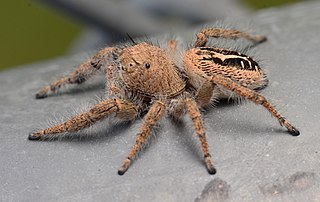
Phidippus texanus is a species of jumping spider in the family Salticidae. It is found in the United States and Mexico.
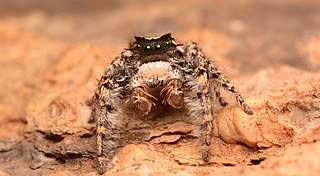
Phidippus carolinensis is a species of jumping spider in the family Salticidae. It is found in the United States and Mexico.
Phidippus comatus is a species of jumping spider in the family Salticidae. It is found in North America.























